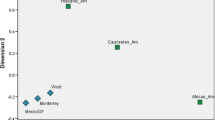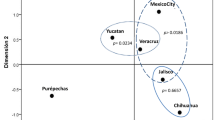Abstract
The PowerPlex® ESI 17 Fast and ESX 17 Fast Systems represent faster cycling versions released by Promega® to follow the requirements of ENFSI and EDNAP groups’ for new STR genotyping systems in Europe. Allele frequencies and forensic parameters were estimated in a population sample of 120 unrelated healthy individuals living in Sicily (Western Sicilian population sample) using PowerPlex® ESI 17 Fast and PowerPlex® 17 Fast Systems. Full concordance of the results for both systems was observed. No significant deviation from Hardy-Weinberg equilibrium was detected. The observed heterozygosity changed from 0.85833 for FGA to 0.95 for TH01. The combined power of discrimination for the 16 loci was >0.999999.
Similar content being viewed by others
Introduction
The International Scientific Community establishes the crucial role of the population studies on allele frequencies and the importance to extend DNA database for forensic purposes. This study analyzed the allele frequencies and genetic parameters of 16 STR loci in a Western Sicilian population sample.
Western Sicily has been the object of many denominations. 120 unrelated Sicilian individuals have been selected for at least 3 generations. This study belongs to the only Western Sicilian population.
Sicily is the biggest and one of the most populated regions in Italy. The Sicilian population amounts approximately to 5,077,487 people (2015), in which only 162,000 are foreigners.
The population study is performed by PowerPlex ESI 17 Fast and ESX 17 Fast Systems designed with the new loci recommended by the European Network of Forensic Science Institutes (ENFSI) and European DNA Profiling Group (EDNAP) (McLaren et al. 2014; Tucker et al. 2011, 2012; Gill et al. 2006).
Materials and methods
DNA extraction
Blood samples and buccal swabs were collected from 120 unrelated occidental Sicilian individuals. DNA was extracted using Prepfiler Forensic DNA Extraction kit (Applied Biosystems – Life Technologies) and a Nanodrop-1000 spectrophotometer (Thermo Scientific, Waltham, MA) was employed to measure the DNA concentration.
Blood samples and buccal swabs were collected anonymously from 120 unrelated healthy individuals living in Western Sicily acquiring their informed consents.
DNA extraction was performed using the Prepfiler Forensic DNA Extraction kit (Applied Biosystems – Life Technologies) according to the manufacturer’s instructions.
Amplification
Approximately 1 ng/μl of template DNA was amplified using PowerPlex ESI and ESX 17 fast System (Promega). The PCR amplification was performed using the GeneAmp PCR System 9700 thermocycler (Applied Biosystems) on the basis of the suggested manufacturer guidelines of the STR kit tested in this study. PCR products were analyzed by capillary electrophoresis and positive and negative controls were carried out as specified in the PowerPlex ESI® and ESX 17® fast System (Promega) user’s manual.
DNA electrophoresis and analysis
All the amplification products were detected by capillary electrophoresis and genotyping was carried out on the ABI PRISM 310 Genetic Analyzer (Applied Biosystems). Data obtained were analyzed using GeneMapper ID v3.2.1 Software (Applied Biosystems).
Population study
Allelic frequencies for all loci and additional relevant forensic parameters such as expected heterozygosity (He) and observed heterozygosity (Ho), polymorphic information content (PIC), power of discrimination (PD) and power of exclusion (PE) were calculated by GenePop (v.4.5.1) software (Rousset 2008). The Hardy–Weinberg equilibrium was tested by the p-value obtained by setting 100 batches with 5000 interactions per batch in the Markov chain method (Guo and Thompson 1992). Allele frequencies of 16 STR and parameters of forensic interest are summarized in Tables 1 and 2.
Results and discussion
All loci exhibited an observed heterozygosity (Ho) greater than 0.85833 (FGA), with the highest value at 0.95 for TH01 and values of polymorphism information content (PIC) ranging between 0.668039 for D22S1045 and 0.970524 for SE33.
The lower power discrimination (PD) was observed for D22S1045 (0.861250) and the highest for D2S1338, D12S391 and SE33 (0.99999) The power of exclusion (PE) ranged from 0.481865 for D22S1045 to 0.9001 for SE33.
The study confirmed that all the markers were useful for forensic purposes: the combined power of discrimination was >0.999999. No significant deviation from Hardy-Weinberg expectations was found. Full concordance at all autosomal loci and amelogenin for both systems was observed.
Allele frequencies for studied 16 STR loci were compared to Italian population data (Berti et al. 2011). The data from Sicilian population was not significantly different from the Italian ones, except for the highest power of discrimination that was observed also for D2S1338 and D12S391.
In conclusion, we report the allele frequencies and forensic statical parameters in a Southern Italian population (Western Sicily). The results contribute to extending knowledge on DNA population data in Italy for forensic purposes. Our data on PowerPlex ESX 17 Fast System and PowerPlex ESI 17 Fast System demonstrate that both systems represent very remarkable tools for forensic human identification and kinship relationship.
References
Berti A, Brisighelli F, Bosetti A, Pilli E, Trapani C, Tullio V, Franchi C, Lago G, Capelli C (2011) Allele frequencies of the new European standard set (ESS) loci in the Italian population. Forensic Sci Int Genet 5(5):548–549
Gill P, Fereday L, Morling N. Schneider PM. The evolution of DNA databases- recommendations for new European STR loci. Forensic Sci Int 2006;156(2–3):242-244
Guo SW, Thompson EA (1992) Performing the exact test of hardy-Weinberg proportion for multiple alleles. Biometrics 48(2):361–372
McLaren RS, Bourdeau-Heller J, Patel J, Thompson JM, Pagram J, Loake T, Beesley D, Pirttimaa M, Hill CR, Duewer DL, Kline MC, Butler JM, Storts DR (2014) Developmental validation of the PowerPlex® ESI 16/17 fast and PowerPlex® ESX 16/17 fast systems. Forensic Sci Int Genet. 13:195–205
Rousset F (2008) Genepop'007: a complete re-implementation of the genepop software for windows and Linux. Mol Ecol Resour 8(1):103–106
Tucker VC, Hopwood AJ, Sprecher CJ, McLaren RS, Rabbach DR, Ensenberger MG, Thompson JM, Storts DR (2011) Developmental validation of the PowerPlex® ESI 16 and PowerPlex® ESI 17 systems: STR multiplexes for the new European standard. Forensic Sci Int Genet. 5(5):436–448
Tucker VC, Hopwood AJ, Sprecher CJ, McLaren RS, Rabbach DR, Ensenberger MG, Thompson JM, Storts DR (2012) Developmental validation of the PowerPlex® ESX 16 and PowerPlex® ESX 17 system. Forensic Sci Int Genet 6(1):124–131
Funding
No funding for the study.
Author information
Authors and Affiliations
Contributions
Study concept and design: EVS, CM, SP. Acquisition of data: SP, SZ, AAsmundo, AArgo. Analysis and interpretation of data: SM, CM, EVS. Drafting of the manuscript: EVS, CM. Study supervision: EVS, CM. All authors read and approved the final manuscript.
Corresponding author
Ethics declarations
Competing interests
The authors declare that they have no competing interests.
Publisher’s Note
Springer Nature remains neutral with regard to jurisdictional claims in published maps and institutional affiliations.
Rights and permissions
Open Access This article is distributed under the terms of the Creative Commons Attribution 4.0 International License (http://creativecommons.org/licenses/by/4.0/), which permits unrestricted use, distribution, and reproduction in any medium, provided you give appropriate credit to the original author(s) and the source, provide a link to the Creative Commons license, and indicate if changes were made.
About this article
Cite this article
Ventura Spagnolo, E., Mondello, C., Procaccianti, S. et al. Allele frequencies distribution of 16 forensic STR loci in a Western Sicilian population sample. Egypt J Forensic Sci 7, 13 (2017). https://doi.org/10.1186/s41935-017-0013-y
Received:
Accepted:
Published:
DOI: https://doi.org/10.1186/s41935-017-0013-y




